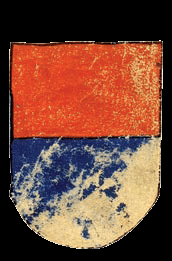
Shield: party per fesse gules and azure (i.e.: the field is divided horizontally into a red and a blue section).
The most recent representations (since the XV century) use the colors red above and blue below. There are also ancient versions with inverted colours (for example see the coat of arms of the Conti di Mede below). Which may have been the original version is unknown.
Crest: Justice dressed in red and blue holding a sword and a pair of scales.
Motto: cum mero et mixto imperio,
Comital coronet: (Grafenkrone of the Holy Roman Empire) a rim of gold jeweled with 16 pearls (of which nine visible in the blazon) set upon high points.
—– ![]() —–
—–
The crest and motto are linked directly to the office of the Count Palatine of the Kingdom of Italy in the Holy Roman Empire (from the Latin comes palatinus ‘count of the palace’).
Emperor Otto III invested Otto I of Lomello of this title and these functions in December 999, making him one of the most

influential figures at his court (source: Treccani Encyclopedia). These distinctive signs were adopted by the family coterie, and kept even as the figure of the Count Palatine gradually lost authority with the imperial institution’s decline.
Thus, unlike many ancient family mottos (which often consisted of a sentence referencing moral values or a battle cry), in this case the motto is a direct reference to institutional prerogatives. In fact, in the Middle Ages, the Count Palatine exercised the sovereign functions of both civil and criminal jurisdiction, and the legal expression at the time used to describe this executive power was: cum mero et mixto imperio. Reference to this judicial function is also present in the crest in the form of Justice with the symbol of fairness, the pair of scales, and the symbol of power, the sword.
 In some versions of the emblem, the original red and blue fesse appears topped by a black eagle with a crown on a yellow background. This was a sign of loyalty to the institution of the Holy Roman Empire which, to symbolize an alleged continuity with the Roman Empire, adopted the eagle of the Roman legions as its distinctive symbol (and still is, by the way, the “Bundesadler”, i.e. the coat of arms of Germany).
In some versions of the emblem, the original red and blue fesse appears topped by a black eagle with a crown on a yellow background. This was a sign of loyalty to the institution of the Holy Roman Empire which, to symbolize an alleged continuity with the Roman Empire, adopted the eagle of the Roman legions as its distinctive symbol (and still is, by the way, the “Bundesadler”, i.e. the coat of arms of Germany).
Other coats of arms, possibly connected to that of the Langosco:



back to the original page in Italian <<![]()


Devi effettuare l'accesso per postare un commento.